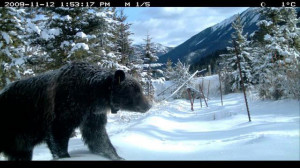“There aren’t a lot of ways for a grizzly bear to die. At least, thats the way it was in the wild.”
Bear 71 is an interactive found-footage documentary following the life of one grizzly, Bear 71, through her life in Banff National Park, which along with being named website of the year in January, recently received the 2013 Webby Award for Best NetArt, a hard-fought category. It was also nominated for the best public service online, best use of video for activism, best use of interactive video and best green website. It’s an example of a new genre appearing online more and more: Documentaries not framed by a cameraman, but constructed from a collection of found footage. In this case, the footage was culled from hundreds of cameras scattered throughout Banff National Park in Alberta, Canada.
The web documentary follows Bear 71 as she navigates a wild now criss-crossed with roads and railways, and dotted with growing settlements. It’s an interesting look at both how human technology, our roads, railways, homes and now computers have encroached on bear territory, but also how that same technology gives us a means to track, observe and understand the animals, or at least the megafauna our urbanization threatens.

The project’s creators, Leanne Allison and Jeremy Mendes, sifted through thousands of hours of grainy footage taken by trail cameras in remote areas of the park to reveal some eye-catching moments: unknowing hikers following in the trail of a pair of mountain lions, grizzly cubs learning to tackle barbed wire fences, tourists, with their inflatable pool toys headed to the river using the same underpass as our grizzly had taken earlier that day. Originally pitched to the National Film Board of Canada as a traditional long-form documentary, Rob McLaughlin, the head NFB’s Vancouver studio, suggested the pair make an interactive project instead.



